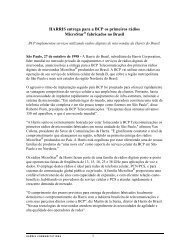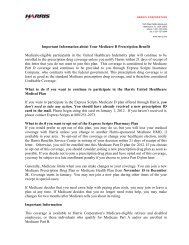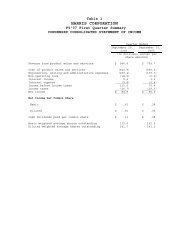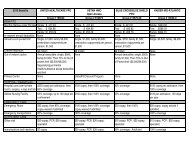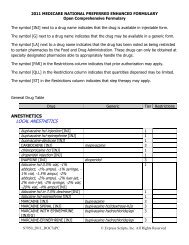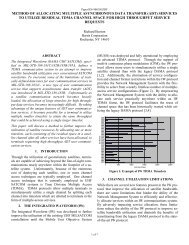harris corporation
harris corporation
harris corporation
Create successful ePaper yourself
Turn your PDF publications into a flip-book with our unique Google optimized e-Paper software.
Additional information relating to our businesses, including our operating segments, is set forth in “Item 7.<br />
Management’s Discussion and Analysis of Financial Condition and Results of Operations” of this Report.<br />
Corporate Governance Principles and Committee Charters. We previously adopted Corporate Governance<br />
Principles, which are available on the Corporate Governance section of our website at www.<strong>harris</strong>.com/<strong>harris</strong>/cg/. In<br />
addition, the charters of each of the standing committees of our Board, namely, the Audit Committee, Business<br />
Conduct and Corporate Responsibility Committee, Corporate Governance Committee, Finance Committee and<br />
Management Development and Compensation Committee, are also available on the Corporate Governance section of<br />
our website. A copy of the charters is also available free of charge upon written request to our Secretary at Harris<br />
Corporation, 1025 West NASA Boulevard, Melbourne, Florida 32919.<br />
Certifications. We have filed with the SEC the certifications required by Section 302 of the Sarbanes-Oxley<br />
Act of 2002 as exhibits to this Report. In addition, an annual CEO certification was submitted by our Chief<br />
Executive Officer to the New York Stock Exchange (“NYSE”) in November 2010 in accordance with the NYSE’s<br />
listing standards, which included a certification that he was not aware of any violation by Harris of the NYSE’s<br />
corporate governance listing standards.<br />
ITEM 1A. RISK FACTORS.<br />
We have described many of the trends and other factors that we believe could impact our business and future<br />
results in “Item 7. Management’s Discussion and Analysis of Financial Condition and Results of Operations” of this<br />
Report. In addition, our business, operating results, cash flows and financial condition are subject to, and could be<br />
materially adversely affected by, various risks and uncertainties, including, without limitation, those set forth below,<br />
any one of which could cause our actual results to vary materially from recent results or our anticipated future<br />
results.<br />
We depend on U.S. Government customers for a significant portion of our revenue, and the loss of this<br />
relationship or a shift in U.S. Government funding priorities could have adverse consequences on our future<br />
business.<br />
We are highly dependent on sales to U.S. Government customers. The percentage of our net revenue that was<br />
derived from sales to U.S. Government customers, including the DoD and intelligence and civilian agencies, as well<br />
as foreign military sales through the U.S. Government, whether directly or through prime contractors, was<br />
approximately 72 percent in fiscal 2011, 75 percent in fiscal 2010 and 74 percent in fiscal 2009. Therefore, any<br />
significant disruption or deterioration of our relationship with the U.S. Government would significantly reduce our<br />
revenue. Our U.S. Government programs must compete with programs managed by other government contractors for<br />
limited resources and for uncertain levels of funding. Our competitors continuously engage in efforts to expand their<br />
business relationships with the U.S. Government and will continue these efforts in the future, and the<br />
U.S. Government may choose to use other contractors. We expect that a majority of the business that we seek in the<br />
foreseeable future will be awarded through competitive bidding. The U.S. Government has increasingly relied on<br />
certain types of contracts that are subject to a competitive bidding process, including IDIQ, GWAC, General<br />
Services Administration (“GSA”) Schedule and other multi-award contracts, which has resulted in greater<br />
competition and increased pricing pressure. We operate in highly competitive markets and our competitors may have<br />
more extensive or more specialized engineering, manufacturing and marketing capabilities than we do in some<br />
areas, and we may not be able to continue to win competitively awarded contracts or to obtain task orders under<br />
multi-award contracts. Further, the competitive bidding process involves significant cost and managerial time to<br />
prepare bids and proposals for contracts that may not be awarded to us, and the risk that we may fail to accurately<br />
estimate the resources and costs required to fulfill any contract awarded to us. Following any contract award, we<br />
may experience significant expense or delay, contract modification or contract rescission as a result of our<br />
competitors protesting or challenging contracts awarded to us in competitive bidding. Budget decisions made by the<br />
U.S. Government are outside of our control and have long-term consequences for our business. A shift in<br />
U.S. Government spending priorities or an increase in non-procurement spending at the expense of our programs<br />
(for example, through “in-sourcing”), or a reduction in total U.S. Government spending, could have material adverse<br />
consequences on our future business.<br />
We depend significantly on U.S. Government contracts, which often are only partially funded, subject to<br />
immediate termination, and heavily regulated and audited. The termination or failure to fund one or more of<br />
these contracts could have an adverse impact on our business.<br />
Over its lifetime, a U.S. Government program may be implemented by the award of many different individual<br />
contracts and subcontracts. The funding of U.S. Government programs is subject to Congressional appropriations.<br />
18




